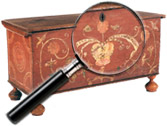|
|
Lydia Field Emmet (1866-1952)
Portraitist Lydia Emmet is especially known for her juvenile subjects. Born in New Rochelle, New York, she was one of ten children. Emmet learned to draw informally by herself in spite of the painting traditions of her family. At eighteen, she traveled to Paris with her sister, Rosina Emmet Sherwood, and studied at the Julian Academy. On her return, she worked as an illustrator of books and magazines, experimented with [...] Click here to continue reading.
Nick Eggenhofer (1897-1985)
At the height of his career, Nick Eggenhofer was known as the “King of the Pulps” for his western dry-brush illustrations. No one could touch him for the authenticity and raw honesty of his subjects. As a young immigrant from Germany, he had steeped himself in the lore of the frontier West, accumulating guns, chaps, Indian headdresses and other props, even building models of everything from stagecoaches to ore wagons to [...] Click here to continue reading.
Charles Henry Ebert (American 1873 to 1959)
Charles Ebert studied in New York City and Paris. When he returned to New York City in 1896, he opened a studio, and became an illustrator for Life Magazine. He and his wife Mary Roberts lived in Greenwich, CT until 1919 and the moved to Old Lyme. Ebert is best known for his painting of Monhegan Island. Today his paintings can be found at the Farnsworth Museum, [...] Click here to continue reading.
Charles Warren Eaton (American, 1857 to 1937)
The American landscape artist, Charles Warren Eaton, remains one of the best kept secrets of the art market. Although his works are included in many public collections across the United States including the National Gallery of Art, the National Museum of American Art, the Brooklyn Museum, Butler Institute of American Art, and the Cincinnati Art Museum, he is virtually an unknown except to the savviest of collectors. [...] Click here to continue reading.
Seth Eastman (1808-1875)
Seth Eastman was a West Point graduate and later a teacher at the academy. He spent five years working on a six volume set with 300+ illustrations authorized by Congress which recorded all of the Indian tribes of America entitled Historical and Statistical Information Respecting the History, Condition and Prospects of the Indian Tribes of the United States.
Information courtesy of Cowan’s Auctions Inc.
Thomas Eakins (1844 to 1916)
Born in 1844, Thomas Eakins grew up in Philadelphia and later studied in Paris. His focus on portrait paintings grew from his appreciation of the candid humanism seen in 17th century Dutch and Spanish paintings. Instead of focusing on lavish, ornate detail aimed to impress the viewer, Eakins shows extreme but honest human emotion in his portraits. His talent and ability to create a somber yet frank tone [...] Click here to continue reading.
Mabel Dwight (1876-1955)
Mabel Dwight was born in Cincinnati, raised in New Orleans, and studied at the Hopkins Art School in San Francisco. A religious socialist, she often produced satirical works about life in the city. She worked in oil, lithography and printmaking. She died in Sellersville, Pennsylvania in 1955.
Information courtesy of Cowan’s Auctions Inc.
Raoul Dufy (French 1877 to 1953)
In 1900 he studied at the Ecole des Beaux-Arts in Paris and experimented with Impressionism admiring the works of Monet and Pissarro, but by 1904 he had adopted the Fauve style of Matisse and began to work in richer colors. He developed his own theory of coleur-lumiere, (heightened ambient color/light) and was the only Fauve whose work retained this brightness. About a year after the war, around 1919 [...] Click here to continue reading.
Victor Dubreuil (American, active circa 1880 to 1910)
Dubreuil remains a rather shadowy figure in the history of trompe l’oeil still life painting, since little of his biography has been traced. He may have been the son of a French couple, Aime T. and Caroline Ferraro Dubreuil, who emigrated to New York around 1847 (Old Money: American Trompe L’Oeil Images of Currency, exhibition catalog, Berry-Hill Galleries, New York, 1988, p. 70). His birth and [...] Click here to continue reading.
Alexander John Drysdale (1870-1934)
Born in Marrieta, Georgia, Alexander Drysdale took classes at the Southern Art Union when his family moved to New Orleans in 1883. From 1901 to 1903, he lived in New York City, and studied with Robert Henri, George Inness, and William Merritt Chase. He returned to New Orleans and painted primarily landscapes. In 1916 he developed a watercolor method of diluting oil paint in kerosene which he then applied with [...] Click here to continue reading.
|
Recent Articles
- Charles Alfred Meurer – American Artist & Tromp L’Oeil Artist
- Sendak, Maurice – American Artist & Writer
- Godie, Lee – American Artist
- Davis, Vestie – American Artist
- Bartlett, Morton – American Artist
- Mackintosh, Dwight – American Artist
- Evans, Minnie Jones – African-American Artist
- Mumma, Ed (Mr. Eddy) – American Artist
- Nice, Don – American Artist
- Savitsky, John (Jack) – American Artist
- Gordon, Harold Theodore (Ted) – American Artist
- Dial, Thornton – African-American Artist
- Doyle Sam – American Artist
- Johnson, Lester Frederick – American Artist
- Finster, Howard – American Artist
|
|
